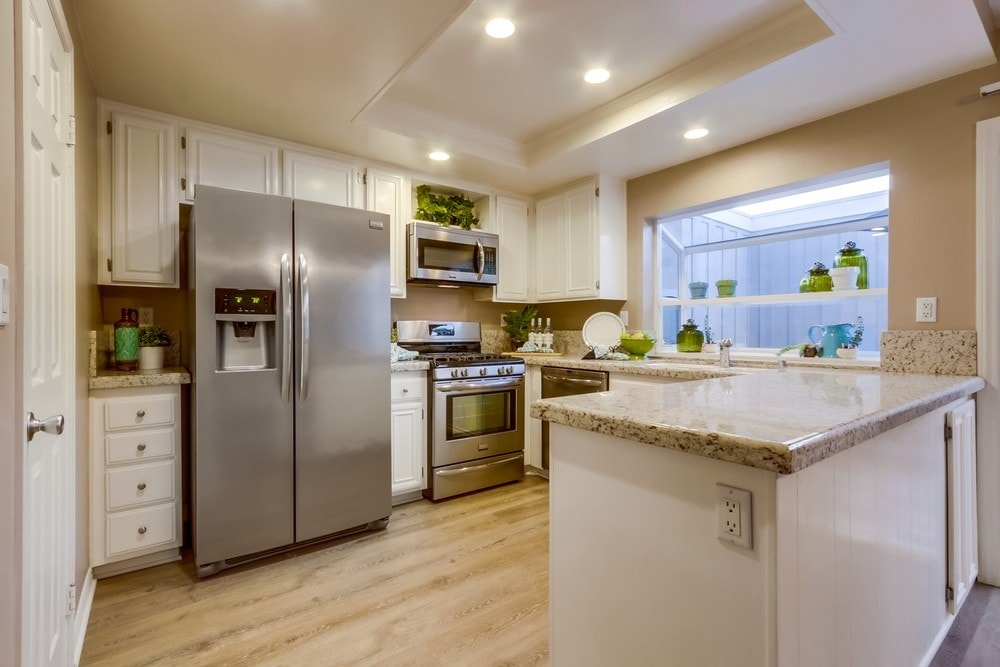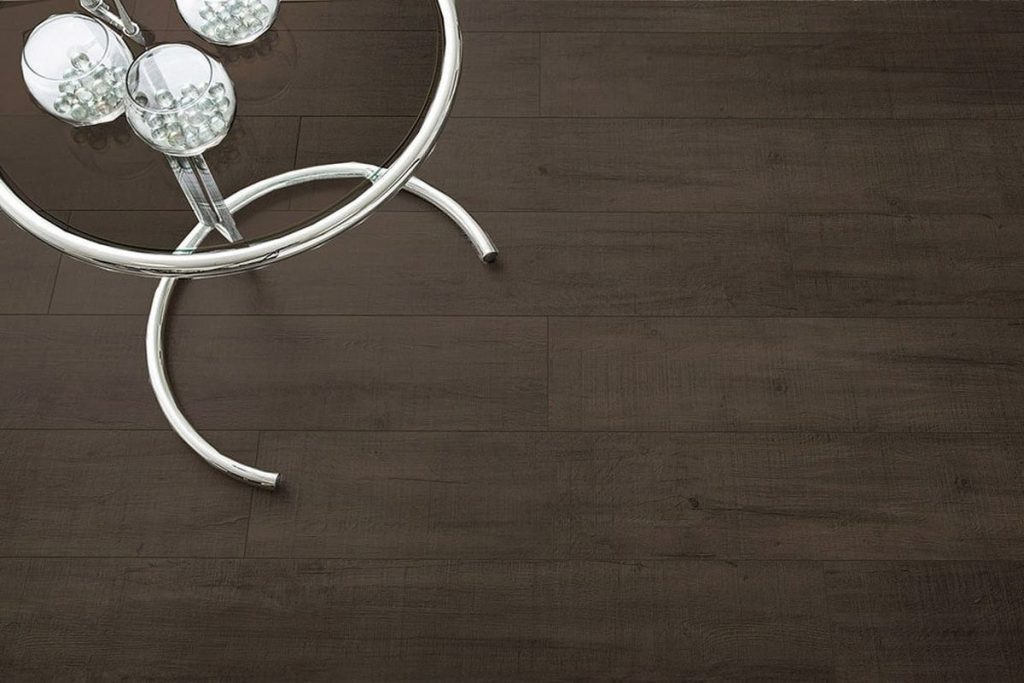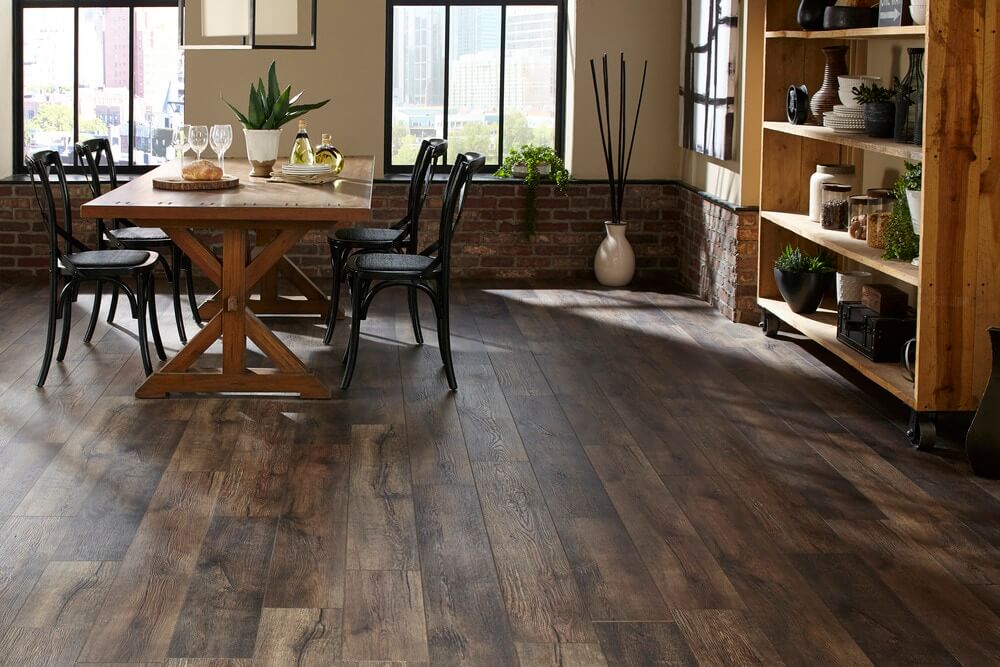The Pros and Cons of Installing Laminate in the Kitchen

When you’re renovating your kitchen, sorting through all the available flooring options can be tough. Many homeowners seem to gravitate toward laminate for its many benefits. Before deciding whether laminate is the right choice for you, delve into this complete list of the pros and cons of installing laminate in the kitchen.
The Pros of Laminate in the Kitchen
Pro: It’s Aesthetically Pleasing
Laminate is considered to be one of the most versatile flooring options for the home. Part of the appeal is that laminate comes in such a diverse range of styles, colors, and patterns. You can choose laminate wood colors that give you the authentic look of hardwood. Rather than having to stain your floors to the right shade, you can simply browse through hundreds of different colors to get the ideal match for your home.
When choosing laminate, you can also go for contemporary or timeless styles. You can find sleek, modern-looking laminate planks and tiles as well as rustic and antiqued versions. Many manufacturers have branched out beyond faux wood floors to offer different colors of laminate flooring, including some that look like stone and metal. Having many aesthetically pleasing options allows you to more easily give your home a makeover that feels personalized, stylish, and unique.

Pro: It’s Cheaper Than Tile and Natural Stone
For many homeowners, the most appealing feature of laminate is its affordable price. Laminate is often sold for as little as $3 per square foot. This price is much cheaper than many other flooring options. For example, when you do the hardwood vs laminate cost, comparison you will find hardwood to be up to five times more expensive.
Laminate flooring offers savings on installation, too. Many types have no nailing, gluing, or stapling required. Instead, the laminate tiles or planks snap together to form a floating floor. In many cases, you don’t have to do anything to the existing floor; you can simply install your laminate on top. Many homeowners are able to tackle this installation on their own and save thousands of dollars on the labor costs required to install other types of flooring.
Pro: Generally Less Defects
Laminate is made to look as realistic as possible while eliminating the defects associated with other types of flooring. For example, with hardwood or natural stone flooring, you may occasionally get pieces with unusual color or pattern variations. These pieces can look out of place on the floor. Homeowners either have to compromise on aesthetics or pay more for replacement pieces that fit in better with the rest of their flooring. Not so with laminate that offers proper wood like flooring options, among others that mimic the look of different natural materials.
When you choose laminate flooring, you’ll get pieces that look as realistic as the real thing but without the unusual defects that can be associated with other flooring types. The colors and patterns are consistent throughout since manufacturers can more easily control the product quality when they make laminate tiles and planks.
Pro: It’s Durable and Easy to Maintain
A clear wear layer is included on top of every piece of laminate flooring. This layer protects the floors from scratches, stains, and fading. Even in areas with abundant foot traffic (such as a kitchen), laminate can hold up quite well. The wear layer adds a level of durability that you won’t find with other types of floors.
The wear layer also creates a smooth, easy-to-clean surface on your laminate floors. Homeowners simply need to sweep the floors regularly to keep them clean. Occasionally, you can use a damp mop for a deeper clean.
The Cons of Laminate in the Kitchen

Con: Possibility of Moisture Damage
Laminate is susceptible to damage when exposed to moisture for extended periods of time. If you occasionally spill water or another liquid on the floor, it’s no big deal. As long as you clean up messes when they occur, they won’t damage your floors. If moisture sits on your laminate floor for an extended time, the dampness could warp and stain the flooring.
Take precautions to prevent moisture damage on your laminate floors. Wipe up any spills quickly and place a rubber mat under pet water dishes. If you mop your floors, wipe them with towels once you’re finished rather than letting any remaining moisture air dry.
Con: It Can’t Be Refinished
Once your laminate floors wear out, they can’t be refinished. Instead, you’ll have to replace the flooring. Since the flooring is assembled with snap-together tiles or planks, you may want to purchase extra pieces that you can insert only if particular areas of your kitchen floor start to wear out over time.
This drawback also has a silver lining. Laminate generally lasts about 15 to 25 years. Some laminate floors may look good for up to 30 years. Since the kitchen tends to be a high-traffic area in the home, look for high-quality laminate if you’d like your flooring to last for 20 years or more.
Con: Eco-Friendliness
If you’re committed to choosing environmentally friendly materials for your kitchen renovation, laminate may not be the best fit for you. Laminate flooring doesn’t degrade well in landfills, partially due to the wear layer which contains plastic. Some laminate flooring options are also made with chemicals such as formaldehyde which can release volatile organic compounds (VOCs). These VOCs are toxic gases that may have adverse health and environmental effects.
In recent years, the Environmental Protection Agency (EPA) has released updated guidelines that require reduced VOC content in laminate flooring. While material containing reduced VOC content is safe to use in your home, it may not be great for the environment overall.
Some versions of laminate flooring are more eco-friendly options than others. Review the following items you want to look for if you want to get laminate with fewer environmental impacts:
- Choose laminate made from sustainably sourced and recycled materials. Some flooring types are approved by the Forest Stewardship Council (FSC). This type of flooring uses wood from sustainably managed forests.
- Find out whether the design has been printed with water-based low-VOC inks.
- Opt for laminate that can be installed without the use of glues or adhesives, materials which may include VOCs.
This list may make you rule out laminate as a possibility for your kitchen. On the other hand, it could make you more confident that laminate is the best choice for your home. Be sure to consider your needs and personal budget when you decide whether laminate is the right fit for your kitchen.




